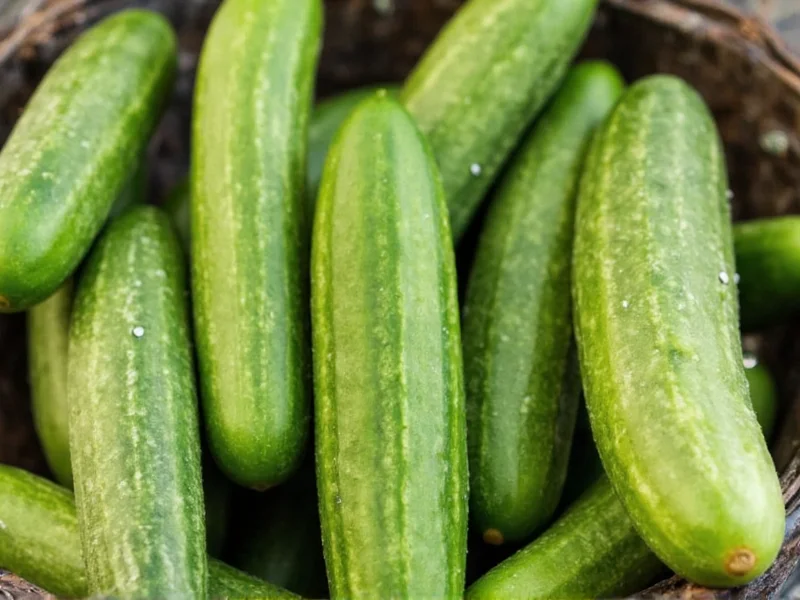Understanding the difference between cucumbers and pickles is essential for both culinary applications and nutritional awareness. While they share the same starting point, the preservation process creates distinct food products with unique characteristics. This article explores the complete transformation process, varieties, and common misconceptions about these popular food items.
The Fundamental Transformation: From Cucumber to Pickle
Cucumbers (Cucumis sativus) are crisp, refreshing vegetables composed of approximately 95% water. When cucumbers undergo the pickling process, they transform into what we commonly call pickles. The key difference lies in the preservation method—fresh cucumbers are perishable and typically last 1-2 weeks refrigerated, while properly pickled cucumbers can remain edible for months or even years.
How the Pickling Process Works
Pickling involves submerging cucumbers in a solution that prevents spoilage while developing distinctive flavors. There are two primary methods:
- Vinegar Pickling: Cucumbers are placed in a solution of vinegar, water, salt, and spices. The acidic environment preserves the cucumbers and creates the characteristic tangy flavor. This method produces what Americans typically call "pickles" and works relatively quickly.
- Fermentation (Brine Pickling): Cucumbers are submerged in a saltwater solution where natural bacteria convert sugars to lactic acid. This traditional method creates "fermented pickles" or "sour pickles" and takes several weeks. The resulting product contains beneficial probiotics.
| Characteristic | Raw Cucumber | Pickle (Vinegar-Processed) | Fermented Pickle |
|---|---|---|---|
| Shelf Life | 1-2 weeks refrigerated | 1-2 years unopened | 6-12 months refrigerated |
| Primary Preservation | Natural state | Vinegar acidity | Lactic acid fermentation |
| Texture | Crisp, high water content | Firm but slightly softer | Distinctively crisp "snap" |
| Nutritional Profile | Low calorie, vitamin K, potassium | Higher sodium, vinegar benefits | Probiotics, higher sodium |
Specialized Cucumber Varieties for Pickling
Not all cucumbers make ideal pickles. Specific varieties have been developed for pickling purposes:
- Pickling cucumbers: Shorter, thicker-skinned varieties like Kirby cucumbers that maintain crispness during processing
- Gherkin cucumbers: Tiny cucumbers (1-5 inches) specifically grown for pickling, often used for cornichons
- Slicing cucumbers: Longer varieties like English cucumbers that are less suitable for pickling due to higher water content
The best pickling cucumbers have bumpy skin, lack of hollow centers, and firm texture that withstands the preservation process without becoming mushy.
Common Misconceptions About Cucumbers and Pickles
Several myths persist about the relationship between cucumbers and pickles:
- "Pickles are a different vegetable": All standard pickles begin as cucumbers—there's no "pickle plant"
- "Pickle juice is just vinegar": Proper pickle brine contains vinegar, salt, spices, and cucumber essence that develops during processing
- "All pickles are sour": Sweet pickles, bread-and-butter pickles, and other varieties demonstrate the flavor range possible through different brine recipes
- "Pickling destroys all nutrients": While some vitamins break down, pickling preserves many nutrients and can enhance bioavailability of others
Nutritional Differences Between Cucumbers and Pickles
The pickling process significantly alters the nutritional profile:
- Sodium content: Pickles contain substantially more sodium (200-500mg per pickle) compared to raw cucumbers (2mg per 100g)
- Vitamin retention: Vitamin C decreases during pickling, while vitamin K remains relatively stable
- Probiotic development: Fermented pickles contain beneficial bacteria not present in raw cucumbers or vinegar-processed pickles
- Glycemic impact: The fermentation process can lower the glycemic index of pickled vegetables
Global Perspectives on Pickles
The term "pickle" varies significantly across cultures, contributing to confusion about whether cucumbers and pickles are the same:
- In North America, "pickle" almost exclusively refers to pickled cucumbers
- In the UK and Commonwealth countries, "pickle" refers to a variety of pickled vegetables and fruits (mango pickle, lime pickle)
- Many languages have distinct terms for pickled cucumbers versus other pickled items
- The word "pickle" comes from the Dutch "pekel" or northern German "pókel," meaning salt or brine
Practical Applications in Cooking
Understanding the difference between cucumbers and pickles helps in proper culinary usage:
- Raw cucumbers work best in salads, sandwiches, and fresh preparations where crisp texture and mild flavor are desired
- Vinegar pickles add tangy flavor to burgers, sandwiches, and as accompaniments to rich foods
- Fermented pickles provide probiotic benefits and complex flavors ideal for charcuterie boards
- Never substitute raw cucumbers for pickles (or vice versa) in recipes without adjusting for moisture content and flavor profile











 浙公网安备
33010002000092号
浙公网安备
33010002000092号 浙B2-20120091-4
浙B2-20120091-4